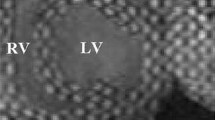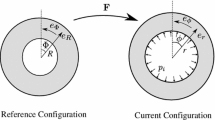Abstract
Most soft biological tissues, including ventricular myocardium, are not stress free when all external loads are removed. Residual stress has implications for mechanical performance of the heart, and may be an indicator of patterns of regional growth and remodeling. Cross-sectional rings of arrested ventricles opened up when a radial cut was made (initial mean opening angles were 64 ± 17°), but further circumferential cuts revealed the presence of additional residual stresses in the tissue with further opening of the rings. In normal mouse hearts, the inner half of a short-axis ring opened more than the outer half, and this change was dependent on apex–base location. At the apex the inner section vs. outer section opening angles were 226 ± 47° vs. 89 ± 28°, while at the base the same two angles were 160 ± 30° vs. 123 ± 35°. A simple theoretical cylindrical shell model with incompressible hyperelastic material properties was used to model the experimental deformations based on the cutting experiments. The model predicts different residual stress fields depending on the nature of the opening after the circumferential cut (which is done after the conventional radial cut). The observed opening angles were consistent with steep stress gradients near the endocardium compared with those predicted if the first cut was assumed to relieve all residual stresses. These results imply a more complex distribution of residual stress and strain in ventricular myocardium than previously thought.
Similar content being viewed by others
Author information
Authors and Affiliations
Additional information
Received: 23 May 2002 / Accepted: 30 September 2002
We would like to acknowledge the surgical skills and data analysis of Zuangjie Li. This work was supported in part by National Heart, Lung, and Blood Institute Grants HL-43026 and HL-64321.
Rights and permissions
About this article
Cite this article
Omens, J., McCulloch, A. & Criscione, J. Complex distributions of residual stress and strain in the mouse left ventricle: experimental and theoretical models. Biomechan Model Mechanobiol 1, 267–277 (2003). https://doi.org/10.1007/s10237-002-0021-0
Issue Date:
DOI: https://doi.org/10.1007/s10237-002-0021-0




